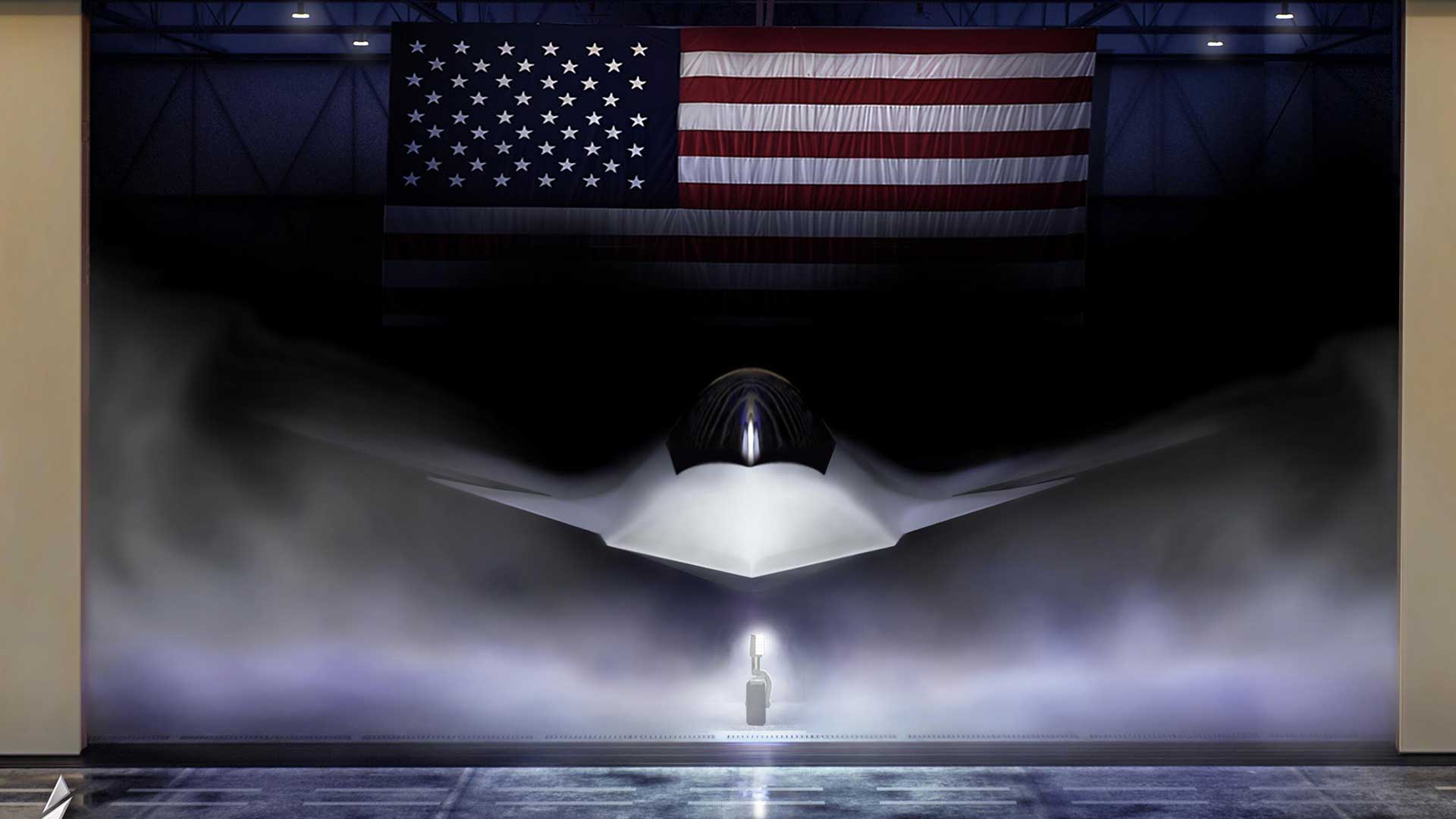Hot News Off The Top Secret U.S. Military Signal Group Chat: The All-New Boeing F-47
Fresh on the heels of Elon Musk’s DOGE governmental sack-a-thon comes the news that the U.S. Air Force is going to spend at least US$20 billion on a brand-new F-47 sixth-generation fighter jet from Boeing. Well, obviously getting rid of the Department of Education is going to make that a lot more affordable!
Why now?
Well, the Lockheed F-22 ‘Raptor’ it’s due to replace, is 20 years old now – which makes it a toothless ole Grandpaw in today’s military when tech advances are by-the-minute rather than by the year. So, in order to keep up with the Joneskis, Huaweis and ‘outpace emerging threats’ in the military aviation world it’s definitely time for a fresh model. Besides, as you can see, it looks pretty cool and Air Force personnel need sexy centrefolds too!
Hot Specs
Unfortunately, because it’s bleeding edge military tech, all the specs are understandably classified. As a result, all we get is a list of vague promises of alleged advances to pore over. Key buzzwords here are:
Sixth generation fighter
The ultimate vague alleged adjective ‘sixth-generation fighter’ doesn’t mean much more than ‘cool and super new with white-hot added freaky tech stuff’ as there aren’t any operational yet anywhere in the world. Logically, sixth-gen should build on fifth-gen capabilities such as stealth, supersonic speed and sensor fusion. Boeing promise the F-47 will have Next-Gen Stealth however with reduced radar cross-section, making detection by enemy air defences even more difficult. So that’s an actual measurable claim to watch for.
System of systems
This is pretty interesting as the U.S. Air Force are pumped about creating military eco-systems rather than just churning out yet more Top Gun-like fighter jets to dogfight with enemy pilots for air superiority. The Autonomous Coordination concept here means the F-47 aircraft would not operate alone but merely as part of an aerial combat strategy, also utilising AI, unmanned drones, advanced sensors and real-time data integration to dominate. Though the Americans have already been using broader aerial strategies before this seems like a very timely further adjustment considering the massive role drones have played in Ukraine and the Middle East.
Adaptability
Though ‘adaptability’ is a tired cliché in the digital space, it possibly has more relevance here as the F-47 will be built with open-architecture software, allowing for rapid upgrades and modifications. Again, this feels like wise learnings from recent swiftly-changing battlefields and aligns with trends seen in aircraft like the F-35, which has struggled with software updates in the past.

Why F-47?
Uh, Donald Trump is the 47th President of the United States, has quite a sizeable ego and ultimately signs off on the purchase – you do the math.
The DoD really shouldn’t have got the President to announce the order however as literally no one in the world believes a word he says, starting with his claim the fleet ‘will be built and in the air during my administration’. At best, initial estimates indicate the jet won’t be operational until the 2030s at the earliest.
Trump also floated the possibility of ally countries purchasing ‘toned down versions’ of the jet. A curious comment seeing as the F-22 was a U.S.-only model due to fears its radar-avoiding design and tech could be reverse-engineered by nefarious enemies.
Does this mean the F-47 is not likely to be so ‘bleeding edge’? Or is it simply that Trump has no idea what he’s talking about? Or he’s merely dangling an invisible carrot to be used to cut some sort of deal?
Quite possibly all three options are in play. But, even if the F-47 were available for sale to ‘U.S. allies’ (whoever or whatever they are these days) Trump isn’t likely to find many buyers. Since his sudden switching sides on Ukraine, countries have started thinking twice about investing in American military hardware. Already Portugal, Canada and possibly even the UK(!) have made noises about finding a new supplier due to Trump’s unreliable behaviour.
What Kill Switch?
Aside from the ‘what the hell is Trump doing now?!’ factor there are genuine fears about buying equipment from a country who doesn’t necessarily align with your nation’s defence sensibilities. Largely because today’s equipment isn’t just hardware, it always comes with a software component which, like your phone or tablet, requires constant upgrades.
So, while the Pentagon and/or Boeing can deny the existence of a ‘kill switch’ in the F-47 – or a remote deactivating of an aircraft by the above due to political pressures – until they are blue in the face, the potential to do so remains. And, if Trump is untrustworthy enough to reverse 80 years’ worth of military alliances more-or-less overnight without consultation, that’s a real problem for Defence Department procurement officers around the globe.
But why Boeing?
If I was going to award a contract for a new aircraft the absolute last company I would consider currently would be Boeing. Their recent reputation is in the toilet with a never-ending series of bad headlines to their name including a slew of fatal air crashes, lengthy worldwide aircraft groundings plus accusations of corner-cutting and shonky manufacturing practices. Oh yes, and their last two CEOs were sacked for prioritising shareholder profit over safety.
Here are just some of the lowlights: 737 MAXs used for Lion Air Flight 610 and Ethiopian Airlines Flight 302 crashed because of Boeing’s faulty Manoeuvring Characteristics Augmentation System (MCAS). As a result all 737 MAX were grounded for nearly two years and Boeing were fined $2.5 billion for fraud as they admitted to withholding critical data about MCAS from pilots and regulators. Yet this wasn’t the end of it, incessant ineptitude in construction, e.g., misdrilled holes and loose rudder bolts halted deliveries and a door plug blew out on an Alaska Airlines flight just last year. The 787 Dreamliner has had a host of problems too with production halted for a year due to gaps in fuselage sections and faulty titanium parts.
Obviously, the professionalism at Boeing’s manufacturing facilities is in serious question too as the U.S. Air Force found tools and rubbish left behind in their new KC-46 Tankers.
Then, a whistleblower named John Barnett who was just about to testify about the Dreamliner’s defective oxygen systems suddenly decided to commit suicide. What a lucky co-incidence for Boeing that was!
Wow, so if that’s Boeing’s standard, the company they were pitching against for the F-47 contract must be the worst manufacturer ever!
Actually, no. Lockheed Martin during the same period of time have had no scandals at all. In fact, the only problem they seem to have is the potential loss of overseas F-35 contracts due to actions by the Trump Administration!
So, looking at this, why the hell would Boeing get the contract?! Why indeed. But remember, Donald Trump is President – and from all accounts, he is not above taking a back-hander or two. Again, you do the math.
A promising but uncertain future
When any new military aircraft are announced, it is hard to draw many conclusions until they actually leave the design tablets and hit the air. Especially if they are to have new ultra secret tech that will ensure ‘global air dominance for decades to come.’ We have no choice but to sift through what the generals are boasting in the hope of finding relevant nuggets of truth.
So far, it sounds like some of the thinking behind the design of the F-47 is sound, but in contrast the political decision-making – as usual – seems less so. The awarding of the F-47 contract to Boeing is concerning from a competence perspective and, unless said manufacturer undergoes a magical transformation, may be simply just the first of many glaring headlines to come.

